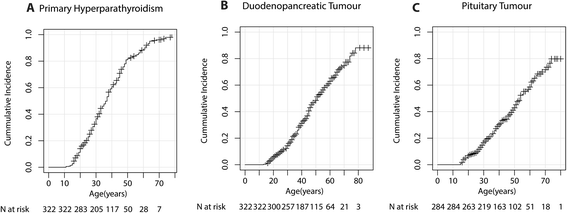MEN1 redefined, a clinical comparison of mutation-positive and mutation-negative patients
- PMID: 27842554
- PMCID: PMC5109674
- DOI: 10.1186/s12916-016-0708-1
MEN1 redefined, a clinical comparison of mutation-positive and mutation-negative patients
Abstract
Background: Multiple Endocrine Neoplasia type 1 (MEN1) is diagnosed when two out of the three primary MEN1-associated endocrine tumors occur in a patient. Up to 10-30 % of those patients have no mutation in the MEN1 gene. It is unclear if the phenotype and course of the disease of mutation-negative patients is comparable with mutation-positive patients and if these patients have true MEN1. The present study aims to describe and compare the clinical course of MEN1 mutation-negative patients with two out of the three main MEN1 manifestations and mutation-positive patients during long-term follow-up.
Methods: This is a cohort study performed using the Dutch MEN1 database, including > 90 % of the Dutch MEN1 population.
Results: A total of 293 (90.7 %) mutation-positive and 30 (9.3 %) mutation-negative MEN1 patients were included. Median age of developing the first main MEN1 manifestation was higher in mutation-negative patients (46 vs. 33 years) (P = 0.007). Mutation-negative patients did not develop a third main MEN1 manifestation in the course of follow-up compared to 48.3 % of mutation-positive patients (P < 0.001). Median survival in mutation-positive patients was estimated at 73.0 years (95 % CI, 69.5-76.5) compared to 87.0 years (95 % CI not available) in mutation-negative patients (P = 0.001).
Conclusions: Mutation-positive and mutation-negative MEN1 patients have a different phenotype and clinical course. Mutation-negative patients develop MEN1 manifestations at higher age and have a life expectancy comparable with the general population. The apparent differences in clinical course suggest that MEN1 mutation-negative patients do not have true MEN1, but another MEN1-like syndrome or sporadic co-incidence of two neuro-endocrine tumors.
Keywords: Diagnosis; MEN1; Survival.
Figures



References
MeSH terms
Substances
LinkOut - more resources
Full Text Sources
Other Literature Sources

